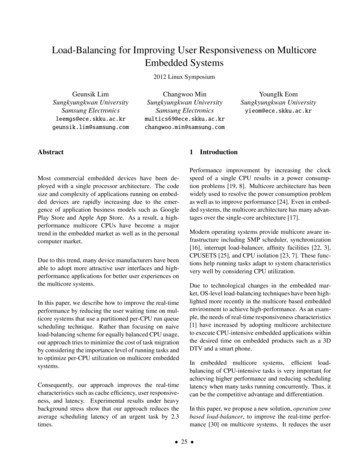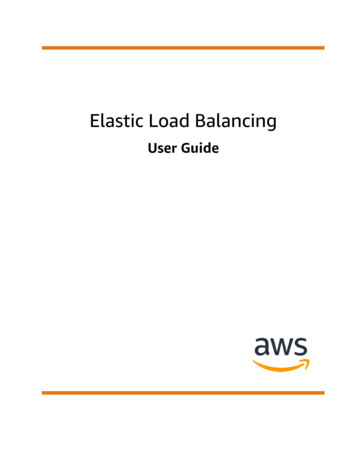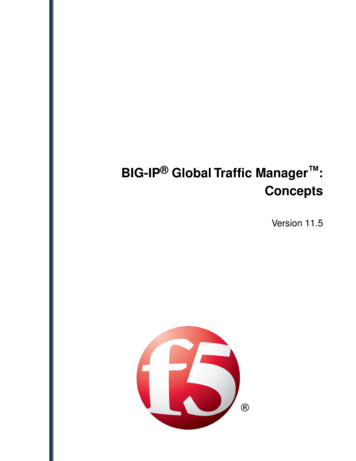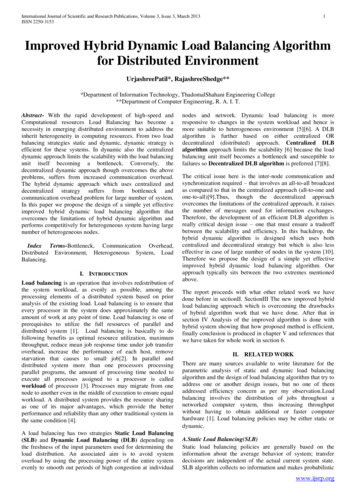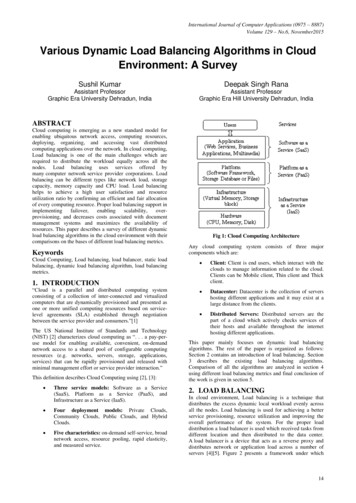
Transcription
loadbalancer.orgWHITE PAPERAn introduction to load balancingWith no technical jargon, this whitepaper describes load balancers in terms everyonecan understand and explains how they improve the performance of web sites, mobileapps and key business systems.
Challenges arisewhen large numbersof users all try toaccess the sameapplications over theInternet at the sametime.Uncompromising expectationsWe have all developed uncompromising expectations. Whether we areshopping in online sales, looking for directions on our mobile phones,accessing corporate file storage systems at work or looking up customer/patient records, we expect to be able to obtain the information we needinstantly. We expect every website to be up and running all of the time anddemand access to our business systems from any device, in any location.Load balancers make this possible. Hidden behind the scenes, in datacenters all around the world, there are millions of load balancers thatkeep all kinds of business, mobile, web and cloud-based applicationsoperational 24/7. They help to ensure that all users get the same high qualityexperience, even throughout exceptional peaks in usage, and deliver thefast, responsive application performance we now take for granted.How do load balancers work?To fully understand how load balancers work, it is important to firstunderstand how applications themselves take instructions from users andrespond with the required information or service.At the simplest level, applications are software programs that have beendesigned to help people perform tasks. Today’s applications enable usto do everything from creating documents to searching for a new homeand accessing our patient records online. While most applications used toreside on individual PCs and laptops, now most applications are accessedover the Internet using a web browser (web apps), from mobile devices(mobile apps) or via corporate networks.These web apps, mobile apps and shared business systems, like email andprint management, all rely on centralized computers called servers, whichdeliver the functionality for the connected devices over the Internet. Whensomeone (the ‘user’) opens a mobile app, accesses a web application viaa web browser or logs into a corporate application, he or she triggers arequest via the Internet to the central web servers or application servers.The servers perform the required task – such as retrieving informationor processing data – and send the information back to the user’s mobile,desktop computer or tablet.Challenges arise when large numbers of users all try to access the sameapplications over the Internet at the same time. The central server canbecome overwhelmed with simultaneous requests and slow down or evenshut down (‘crash’), resulting in poor performance and a bad experience forthe user. To address this, most organizations will run their applications onmultiple servers, known as a cluster of servers, giving them more computingpower and the capacity to meet the needs of large numbers of users.What do load balancers do?Load balancers sit in between the Internet and clusters of servers anddistribute all the requests from users across the available servers. Theydo this in a number of different ways, the most basic of which is ‘Roundwww.loadbalancer.org sales@loadbalancer.org Whitepaper 0343-WP-G-01
Robin’, whereby each new user request is allocated to the next server inthe sequence. There is also the ‘Least Connection’ approach, in whichuser requests are directed to the server in the cluster that currently has thefewest connections. Alternatively, in the ‘Lowest Response Time’ method,the load balancer automatically directs traffic to the server that will respondto the user request in the fastest time.Offering more sophisticated functionality thanthe embedded vendor solutions, third party loadbalancers distribute traffic across storage nodesin the scale-out NAS environment more logically.A new generation of intelligent load balancing solutions is now available thatallows organizations to make more nuanced decisions about how to bestbalance user requests (or ‘traffic’) across their servers to improve applicationperformance. Such solutions include functionality for routing user requestsnot just based on the number of connections per server, but on the type ofrequests and the current load on the server.Organizations can also use load balancers to identify the individual device(the user’s IP address) and route each user to a specific server or to keepsending users to the same server (known as ‘persistence’). This function isparticularly useful in the case of ecommerce websites, as it can be used toensure that users don’t repeatedly lose their shopping carts every time theyare directed to a different server. EXAMPLE 1Load balancers with print management andworkflow systemsUnder the hood of every organization is an intricate web of document andinformation-sharing, both physical and digital. This is orchestrated by printmanagement and document workflow applications. Whether submittingexpense forms for approval, printing reports for distribution, managingcustomer engagement journeys, or securing classified documentation– for organizations with large numbers of employees, there’s no betterway to effectively manage document sharing, administer the securityof sensitive information, or keep printing costs down. Performing suchan essential role means it’s critical that these applications are working,and working optimally, at all times – and enterprise vendors are nowrecognising the fundamental benefits of load balancers to make thesebusiness-critical environments resilient and high-performing.Load balancers themselves come in different forms. They can be hardwaredevices that physically sit in datacenters or at organizations’ premises;equally they can be software-only solutions that are installed on physical orvirtual servers in datacenters, on premise or in the cloud. Some vendorscombine load balancing functionality with additional capabilities, such aswww.loadbalancer.org sales@loadbalancer.org Whitepaper 0343-WP-G-01
For thoseorganizations thatsimply need loadbalancing capabilities,standard hardwareand software basedload balancers aregenerally inexpensiveand easy to installand manage.security features. These multi-faceted solutions (known as ApplicationDelivery Controllers) offer a wide range of sophisticated, customizablecapabilities that go far beyond just load balancing, but can be complex tomanage and costly. For those organizations that simply need load balancingcapabilities, standard hardware and software-based load balancers aregenerally inexpensive and easy to install and manage.What are the benefits of load balancing?Using load balancers enables organizations to:Ensure apps are always availableLoad balancers help organizations to keep their critical applications up andrunning 99.999% of the time. If one server in a cluster breaks down, theload balancers will automatically and instantly direct user requests to analternative server instead. This significantly reduces the risk of downtime,which, at best, is deeply annoying for users and, at worst, could have asignificant impact on an organization’s revenues and reputation. If a medicalfacility were to experience downtime in a vital diagnostic system, the loss ofthe application could impede doctors’ ability to save lives.Deliver a consistently good user experienceBy directing user requests to the servers that are best able to respondquickly, load balancers can provide consistent and fast app performancefor thousands of concurrent users. Indeed, some web apps today handlethousands of user requests a second and rely on load balancers to returninformation, images or video instantly. Being able to deliver fast responsetimes, enables organizations to ensure that their employees can workproductively and their customers can have an enjoyable online experience.www.loadbalancer.org sales@loadbalancer.org Whitepaper 0343-WP-G-01
Cope with surges in application usageSome peaks in demand can be anticipated, such as increased ecommercetraffic on Black Monday. However, organizations also need to be preparedfor unexpected surges in demand and plan for future growth. Whenthey have load balancers installed to manage their application traffic,organizations can dynamically add more servers to respond to growing usernumbers – and they can do this quickly and easily, without having to takedown their apps temporarily or reconfigure the other servers in the cluster.Maintain servers and apps cost effectivelyLoad balancers give IT managers the flexibility to manage and maintain theirweb servers and application servers more easily. They can disconnect,patch, upgrade and reconnect one server, without impacting the operationof the remaining servers and, importantly, without causing any disruption toapp performance for users. Server maintenance activities can also be morecost effective, as IT teams do not have to be paid overtime to undertakeroutine maintenance outside of usual business hours or at weekends. EXAMPLE 2Load balancers with storage solutionsLarge organizations commonly have centralized IT systems for storing alldocuments and data created and used by all employees. These storagesolutions are intelligently designed to recover or rebuild following anunexpected failure, but they don’t account for the needs of the users.Load balancers are therefore required to help ensure that all users haveconsistent, fast access to the documents and information they need todo their jobs. No matter where in the world the employee or the storagesystem is located, the load balancers will direct user requests to the mostappropriate server to ensure that the employee can work productively.Even during peak periods and with heavy loads, the load balancers willensure that users’ performance expectations are met.www.loadbalancer.org sales@loadbalancer.org Whitepaper 0343-WP-G-01
What is the difference between load balancing andlink balancing?Load balancersdeliver two vitallyimportant benefits:zero downtime andoptimum applicationperformance.Link balancers (sometimes called link load balancers) are often confusedwith load balancers but, in fact, fulfill an entirely different role. Linkbalancers sit between a corporate network (the local area network or LAN)and larger geographic networks or telecommunications networks (knowsas the wide area network or WAN). Link balancers then distribute requestsfrom PCs, laptops and other devices connected to the LAN, across multipleInternet links to the best available destination.In summary then, link balancers control how user requests reach theinternet, while load balancers control how user requests are handled oncethey have travelled through the internet and have reached the destinationapplications. EXAMPLE 3Load balancers with Healthcare solutionsIn the medical industry, it is absolutely critical for key IT systems, such ashealthcare imaging solutions, to be available and performing optimallyall of the time. Doctors and clinicians need to have instant access tomedical images, such as x-rays and CT scans, 24 hours a day, every day,to enable them to diagnose conditions, prescribe treatments and savelives. Load balancers are used to balance traffic to healthcare imagingsystems and seamlessly divert user requests to alternate servers, in theevent that one server fails, preventing downtime. Healthcare imagingsystems are replaced infrequently, so load balancers also play a key rolein helping to ensure that these vital applications can carry on deliveringgood performance for users over time, as the volume of archived imagesand usage grows.www.loadbalancer.org sales@loadbalancer.org Whitepaper 0343-WP-G-01
Want to know more?If you would like more information about the essential role played by load balancers in object storage environmentsor have any questions about Loadbalancer.org’s solutions and services in this industry, please get in touch.About Loadbalancer.orgLoadbalancer.org’s mission is toensure that its clients’ businesses arenever interrupted. The load balancerexperts ask the right questions to getto the heart of what matters, bringinga depth of understanding to eachdeployment. Experience enablesLoadbalancer.org engineers to designless complex, unbreakable solutions and to provide exceptional personalisedsupport.
Link balancers (sometimes called link load balancers) are often confused with load balancers but, in fact, fulfill an entirely different role. Link balancers sit between a corporate network (the local area network or LAN) and larger geographic networks or telecommunications networks (knows as the wide area network or WAN).

